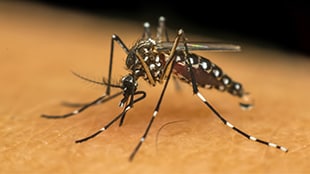Florida Uses Emergency Department and Urgent Care Data to Strengthen Case-based Surveillance of Dengue

Dengue is a major public health threat worldwide and a major cause of illness with fever in travelers returning to the United States. Infection can be deadly if left untreated. Dengue virus is spread through the bite of infected mosquitoes. There have been unprecedented increases in travel-related dengue cases in Florida, particularly among travelers from Cuba. Because Florida is home to the mosquito species that can carry dengue virus (Aedes aegypti and Aedes albopictus), the risk for local transmission increases. In 2022, Florida reported over 900 travel-related cases and over 60 locally acquired cases.
The Florida Department of Health (FDOH) assessed data sources to improve detection of dengue cases. Their findings suggest that searching electronic health data from emergency department and urgent care visits focusing on dengue-like symptoms and travel history can help with identifying cases earlier and taking public health action.
Public Health Problem
In 2022, Florida reported a dengue outbreak and the most overall cases since 2009. Because dengue is not endemic to Florida, viral transmission from imported cases to the local mosquito population is a concern. Healthcare providers are required by state law to report any suspected dengue cases directly to county health departments (CHDs) immediately upon suspicion.1 Early reporting is important for prompt mosquito control efforts to reduce the risk of potential local transmission. However, historically, most cases are identified through electronic laboratory results (ELR) from commercial laboratories after test results are available, which can take 7–10 days. This lag between when a person becomes sick and when test results are available can make it challenging to rapidly identify cases, especially during an outbreak. Enhanced syndromic surveillance queries are used during outbreaks to identify emergency department and urgent care visits when dengue is suspected.
Actions Taken
FDOH uses ESSENCE–FL* for rapid monitoring of patient symptoms and diagnoses to detect possible cases and assess disease trends. Due to the large number of travel-related dengue cases and continuing risk to Florida, FDOH conducted daily ESSENCE–FL queries during the 2022 outbreak. These queries searched health care visit data for travel history to Cuba, travel to other dengue-endemic regions, chief complaint fields for dengue-like symptoms such as fever, rash, thrombocytopenia (i.e., low blood platelet counts), and gastrointestinal symptoms; and discharge diagnoses for arboviral ICD-10 codes.
Suspected dengue cases are reported to CHDs by ELR, provider reports, or through ESSENCE–FL queries. Records of interest are forwarded to CHDs to investigate and determine if the national case definition is met or to determine if follow-up testing for dengue should be considered.2 FDOH reviewed case investigation data for 628 travel-related cases and 37 locally acquired dengue cases during June–November 2022 to determine how cases were first reported to CHDs. FDOH also analyzed the time from symptom onset to mosquito control notification for each reporting category.
Outcome
Over 40% (290) of all cases were first identified through syndromic surveillance using ESSENCE–FL. Only 6% (39) were initially reported by health care providers.3 ESSENCE–FL queries helped accurately detect cases earlier and detect dengue cases that would not have otherwise been diagnosed. This includes the northernmost locally acquired case in the state that was only detected by reviewing symptoms reported in ESSENCE–FL and subsequent dengue testing by the local health department.
Lessons Learned
ELR and syndromic surveillance provided most reports of dengue cases during the outbreak. Although case reporting from healthcare providers in Florida was low, identification of cases from provider reports or syndromic surveillance allowed for earlier public health interventions, such as mosquito spraying, to reduce potential local transmission. Early identification by ESSENCE–FL enabled CHD investigation and mosquito control intervention more than 3 days sooner than cases received by electronic laboratory results. In addition, outreach to healthcare providers encourages early recognition of dengue illnesses and prompt reporting.
*Electronic Surveillance System for the Early Notification of Community-based Epidemics–Florida
2. Dengue Virus Infections 2015 Case Definition. https://ndc.services.cdc.gov/case-definitions/dengue-virus-infections-2015/.
3. Saunders KE, Morrison A, Zimler R, et al. Syndromic Surveillance in Dengue Outbreak Response—Florida, 2022. 26 June 2023. Oral Presentation in 2023 CSTE National Conference. Salt Lake City, UT.
Resources
CDC Website: Dengue
Contact
Epidemic Intelligence Service Officer
Centers for Disease Control and Prevention
Assigned to: Florida Department of Health
Centers for Disease Control and Prevention
Office of Public Health Data, Surveillance, and Technology
Detect and Monitor Division
www.cdc.gov/nssp
The findings and outcomes described in this syndromic success story are those of the authors and do not necessarily represent the official position of the National Syndromic Surveillance Program or the Centers for Disease Control and Prevention.
